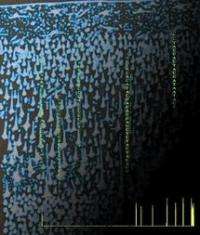Researchers produce detailed map of gene activity in mouse brain

A new atlas of gene expression in the mouse brain provides insight into how genes work in the outer part of the brain called the cerebral cortex. In humans, the cerebral cortex is the largest part of the brain, and the region responsible for memory, sensory perception and language.
Mice and people share 90 percent of their genes so the atlas, which is based on the study of normal mice, lays a foundation for future studies of mouse models for human diseases and, eventually, the development of treatments. Researchers from the National Human Genome Research Institute (NHGRI), part of the National Institutes of Health, and from Oxford University in the United Kingdom, published a description of the new atlas in the Aug. 25, 2011, journal Neuron. The study describes the activity of more than 11,000 genes in the six layers of brain cells that make up the cerebral cortex.
"This study shows the power of genomic technologies for making unexpected discoveries about the basic biology of life," said NHGRI Director Eric D. Green, M.D., Ph.D. "The brain is our most complex organ. Until we understand how it is built and how it functions based on our genetic blueprint, we will be hampered in keeping the brain healthy or dealing with its terrible diseases."
To map gene activity in all six layers of the mouse cerebral cortex, the research team first micro-dissected the brains of eight adult mice, separating the layers of the cortex. They then purified processed RNAs, including messenger RNA, from each cortical layer.
The cell creates messenger RNA (mRNA) when genes are switched on and the DNA code is read out to make proteins. The presence of an mRNA indicates that a gene is turned on, and the amount of mRNA shows the extent to which the gene is active.
To determine which genes were turned on and to what extent, the researchers used a relatively new sequencing technology called RNA-seq. The technique depends on two steps. The researchers first copy processed RNA into a form of DNA, and then sequence the resulting DNA on a second-generation, DNA sequencing instrument. The resulting massive data set must then be analyzed by a cluster of computers to determine which genes have been turned on in the brain cells and to what extent.
The international collaborators have made the new atlas freely available at http://genserv.anat.ox.ac.uk/layers.
By determining the gene activity in each layer, researchers believe it will be possible to connect brain anatomy, genetics and disease processes with greater precision. The research team found that more than half of the genes expressed in the mouse cerebral cortex showed different levels of activity in different layers. These differences point to the areas where specific genes play important roles.
"We found that genes associated with some human diseases were more active in certain layers. For example, we detected genes previously associated with Parkinson's disease in layer five and Alzheimer's disease in layers two and three. These are correlations, not necessarily causal, but they do suggest directions for future research," said T. Grant Belgard, lead author of the paper and an NIH-Oxford fellow in NHGRI's Genome Technology Branch. "Knowing the detailed pattern of expression of all genes in the cortex and how this fits into the overall brain architecture will help us understand how genes act together to sustain the cells and circuits that underlie behavior and disease."
Using the technique, researchers detected a vast array of noncoding RNAs. These are RNAs produced from DNA that do not encode proteins, but probably play a critical role in regulating genes and controlling biological processes. Some of these were active in specific layers, and many had not previously been discovered.
The study also further demonstrated the importance of alternative splicing in gene function within the brain. Messenger RNA includes segments called exons that can be stitched together in different ways to produce a mature message that the cell uses to produce proteins. The alternative splicing process allows a single gene to produce many different proteins that can have different functions in different cells or at different times in a cell's life.
Many alternatively spliced genes showed different distributions of the alternative forms between layers. This includes the Mtap4 gene, whose activity is altered in Alzheimer's disease.
Next year, Belgard and others will be involved in an effort to replicate the mouse brain atlas for parts of the human brain.















